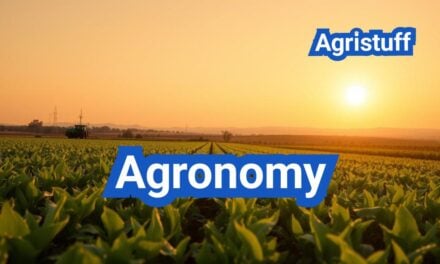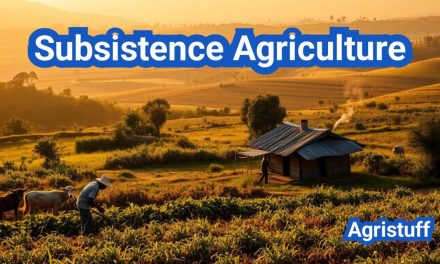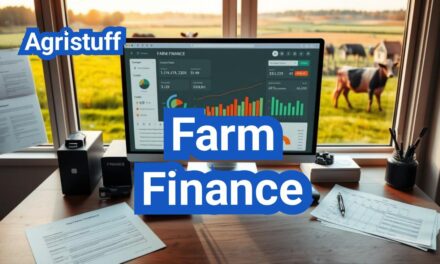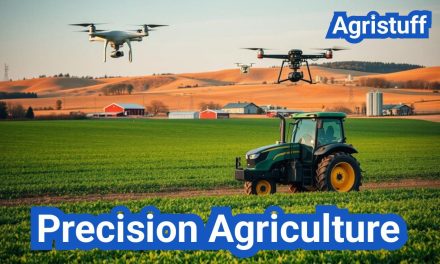Intensive agriculture is a farming method that involves using large amounts of labor and investment to boost crop yields.
This approach to farming has become a cornerstone of modern agricultural practices, enabling farmers to increase productivity and meet the world’s growing food demands.
The use of pesticides, fertilizers, and machinery in intensive cultivation has revolutionized the way crops are grown, allowing for more efficient and effective farming practices.
By understanding the core concepts and historical development of intensive agriculture, we can better appreciate its significance in today’s agricultural landscape.
Key Takeaways
- Intensive agriculture is a method of farming that uses large amounts of labor and investment.
- This approach to farming has become crucial in meeting the world’s growing food demands.
- Pesticides, fertilizers, and machinery are commonly used in intensive cultivation.
- Understanding intensive agriculture is essential for appreciating its significance in modern farming.
- Intensive agriculture has revolutionized the way crops are grown.
What Is Intensive Agriculture?
The practice of intensive agriculture has been around for centuries, with its roots tracing back to ancient civilizations. This farming method has evolved significantly over time, influenced by technological advancements, economic factors, and environmental considerations.
Definition and Core Concepts
Intensive agriculture is characterized by its high-input, high-output approach to farming. It involves the use of significant resources such as labor, capital, and technology to maximize crop yields and productivity on a given piece of land.
The core concepts of intensive agriculture include:
- High-Yield Crops: Selecting crop varieties that are bred for higher yields and better disease resistance.
- Advanced Irrigation Systems: Implementing efficient irrigation systems to optimize water use.
- Mechanization: Using machinery to reduce labor costs and improve efficiency.
- Chemical Inputs: Applying fertilizers and pesticides to enhance growth and control pests.
Historical Development and Evolution
Intensive agriculture has its roots in ancient civilizations, with evidence of its practice found in regions such as ancient Egypt and Mesopotamia. The modern version of intensive agriculture emerged during the Industrial Revolution, with the introduction of new technologies and farming practices.
Key milestones in the evolution of intensive agriculture include:
- The introduction of the steel plow, which allowed for deeper and more efficient tilling of the soil.
- The development of synthetic fertilizers and pesticides, which significantly increased crop yields.
- The mechanization of farming through the use of tractors and other machinery.
- The application of precision agriculture techniques, including GPS and drone technology.
These advancements have transformed intensive agriculture into a sophisticated and highly productive farming system, capable of meeting the food demands of a growing global population.
Intensive vs. Extensive Agriculture: Key Differences

The distinction between intensive and extensive agriculture lies at the heart of modern farming practices. Understanding these differences is essential for evaluating the effectiveness and sustainability of various agricultural methods.
Extensive Agriculture Definition and Characteristics
Extensive agriculture involves farming over large areas with relatively low inputs, such as labor and capital, per unit of land. This approach is characterized by:
- Large land holdings
- Lower crop yields per hectare
- Mechanized farming techniques
- Lower labor intensity
Extensive agriculture is often practiced in regions with abundant land and low population density. It relies heavily on machinery and technology to manage vast areas efficiently.
Land Use and Productivity Comparison
When comparing intensive and extensive agriculture, land use and productivity are critical factors. Intensive agriculture focuses on maximizing yields from a smaller land area through high-input practices, resulting in higher productivity per hectare. In contrast, extensive agriculture spreads its resources over larger areas, leading to lower productivity per hectare but potentially higher total output.
A key difference between the two approaches is their impact on land use. Intensive agriculture promotes efficient use of land, allowing for higher yields on smaller plots. Extensive agriculture, while using more land, can lead to issues like soil degradation if not managed properly.
Economic and Environmental Considerations
Economic considerations play a significant role in choosing between intensive and extensive agriculture. Intensive farming often requires substantial investment in inputs like fertilizers and machinery but can yield higher economic returns per hectare due to increased productivity. Extensive farming, with its lower input costs, may offer better economic viability in regions where land is abundant and labor is scarce.
From an environmental perspective, both approaches have their challenges. Intensive agriculture can lead to environmental issues such as water pollution and soil degradation due to high chemical inputs. Extensive agriculture, if not managed sustainably, can result in habitat loss and soil erosion.
The choice between intensive and extensive agriculture depends on a variety of factors, including land availability, economic conditions, and environmental concerns. By understanding the key differences between these two approaches, farmers and policymakers can make informed decisions that balance productivity with sustainability.
Types of Intensive Agricultural Systems
Intensive agricultural systems are categorized into several types based on their purpose and methodology. These systems are designed to maximize productivity and efficiency, catering to various needs and environments.
Intensive Commercial Agriculture
Intensive commercial agriculture involves the large-scale production of crops and livestock for market sale. This type of agriculture relies heavily on technology, machinery, and chemical inputs to increase yield and reduce labor costs. Commercial farms often focus on a single crop or a limited range of crops, allowing for specialization and economies of scale.
Intensive Subsistence Agriculture
In contrast, intensive subsistence agriculture is practiced to meet the food needs of the farmer’s family or local community. This type of farming is labor-intensive and often involves the cultivation of multiple crops on a small plot of land. Subsistence farmers typically use traditional farming techniques and may have limited access to modern technology and external inputs.
Bio-Intensive Agriculture
Bio-intensive agriculture is a method that focuses on maximizing yields while minimizing environmental impact. This approach involves using natural and organic methods to improve soil fertility, conserve water, and promote biodiversity. Bio-intensive farming techniques include crop rotation, composting, and the use of cover crops to maintain soil health.
Intensive Urban Farming
Intensive urban farming refers to the practice of growing crops in urban areas, often using innovative techniques such as vertical farming, hydroponics, and container gardening. This type of agriculture helps to increase food security in urban areas and can provide fresh produce to local communities. Urban farms can be established on rooftops, in abandoned lots, or even indoors, making efficient use of available space.
In conclusion, the various types of intensive agricultural systems offer different approaches to achieving high productivity and efficiency. By understanding these systems, farmers and policymakers can make informed decisions about the best practices to adopt in different contexts.
Essential Inputs for Successful Intensive Farming

The success of intensive farming practices hinges on the effective use of essential resources. Intensive farming requires a combination of critical inputs to maximize yields and maintain productivity.
Fertilizers and Chemical Inputs
Fertilizers and chemical inputs are crucial for intensive farming, providing necessary nutrients for crop growth and pest control. The use of nitrogen-based fertilizers has been particularly effective in enhancing crop yields.
A study by the International Fertilizer Association highlights that the strategic application of fertilizers can increase crop production by up to 50%. However, it’s essential to balance fertilizer use with environmental considerations to prevent soil degradation.
Water Resources and Irrigation
Adequate water supply is vital for intensive farming, with irrigation playing a key role in maintaining consistent crop growth. Modern irrigation techniques, such as drip irrigation, have significantly improved water efficiency.
According to a report by the Food and Agriculture Organization, efficient irrigation systems can reduce water usage by up to 30% while maintaining or increasing crop yields.
| Irrigation Method | Water Efficiency | Crop Yield Impact |
|---|---|---|
| Drip Irrigation | High | Significant Increase |
| Flood Irrigation | Low | Moderate Increase |
| Sprinkler Irrigation | Medium | Moderate Increase |
Capital and Technology Requirements
Intensive farming demands substantial capital investment in technology, including precision agriculture tools and machinery. The adoption of precision farming technologies has been shown to enhance productivity and reduce waste.
“Precision agriculture is revolutionizing the way we farm, enabling farmers to make data-driven decisions and optimize resource use.” –
Precision Agriculture Expert
Labor Resources and Management
Labor is another critical input for intensive farming, requiring skilled workers for crop management and machinery operation. Effective labor management is essential for maintaining productivity and ensuring the success of intensive farming operations.
- Training programs for farm workers
- Efficient labor allocation strategies
- Mechanization to reduce labor intensity
Modern Techniques in Intensive Agriculture
Intensive agriculture has witnessed a significant transformation with the integration of cutting-edge technologies. These modern techniques have not only improved crop yields but also enhanced the overall efficiency of farming practices.
Precision Agriculture Technologies
Precision agriculture involves the use of advanced technologies such as GPS, drones, and satellite imaging to optimize crop management. Precision farming techniques enable farmers to make data-driven decisions, reducing waste and improving productivity.
According to a report, “Precision agriculture has the potential to increase crop yields by up to 20% while reducing the environmental impact of farming practices.”
“The use of precision agriculture technologies is revolutionizing the way we farm, making it more efficient and sustainable.”
Vertical Farming Systems
Vertical farming is another innovative approach that involves growing crops in vertically stacked layers, often in indoor environments. This method allows for year-round production and can significantly reduce land use.
Vertical farming systems are particularly beneficial in urban areas where land is scarce. They provide a reliable source of fresh produce to local communities.
Hydroponics and Aeroponics
Hydroponics and aeroponics are soilless cultivation methods that offer numerous benefits, including water conservation and increased crop yields. Hydroponic systems involve growing plants in nutrient-rich solutions, while aeroponics uses a fine mist to deliver nutrients.
These methods are highly efficient and can be used in a variety of settings, from small-scale indoor gardens to large commercial operations.
Intensive Wheat Management and Other Grain Cultivation
Intensive wheat management involves the use of advanced agronomic practices to maximize wheat yields. This includes the application of precision agriculture techniques, optimized irrigation systems, and crop rotation strategies.
Similarly, other grain crops such as corn and soybeans can benefit from intensive management practices, leading to improved productivity and reduced environmental impact.
How to Implement Intensive Farming Practices

Intensive farming implementation involves a multi-step process that begins with assessing the land’s potential for intensive agricultural use. This initial assessment is crucial for determining the feasibility of intensive farming on a particular piece of land.
Assessing Land Suitability
Before implementing intensive farming practices, it’s essential to evaluate the land’s suitability. This involves analyzing soil type, topography, climate, and water availability. Farmers must consider factors such as soil fertility, drainage, and erosion potential to ensure that the land can support intensive agricultural activities.
Planning Crop Selection and Rotation
Crop selection and rotation are critical components of intensive farming. Farmers should choose crops that are well-suited to their local climate and soil conditions. Crop rotation helps maintain soil fertility, reduce pest and disease pressure, and increase overall yields. A well-planned crop rotation strategy can also help mitigate the environmental impacts of intensive farming.
Designing and Implementing Irrigation Systems
Effective irrigation is vital for intensive farming, as it ensures that crops receive the right amount of water at the right time. Farmers should design irrigation systems that are efficient, reliable, and tailored to their specific crop needs. This may involve using drip irrigation or sprinkler systems to minimize water waste and optimize water use.
Developing Monitoring and Management Strategies
Intensive farming requires continuous monitoring and management to ensure that crops are healthy and thriving. Farmers should implement monitoring systems to track soil moisture, temperature, and crop health. This information can be used to make informed decisions about irrigation, fertilization, and pest management, ultimately leading to higher yields and more sustainable farming practices.
By following these steps and implementing intensive farming practices effectively, farmers can achieve higher productivity, improve resource efficiency, and contribute to a more sustainable food system.
Intensive Crop Production Methods

To address food security concerns, farmers are increasingly adopting intensive crop production methods. These methods are designed to maximize yields and improve crop quality, ensuring a stable food supply for the growing global population.
Monoculture Farming Techniques
Monoculture farming involves growing a single crop on a large area of land. This technique allows for specialization and economies of scale, potentially increasing efficiency and reducing costs. However, it also requires careful management to avoid soil degradation and pest infestations.
Benefits of Monoculture: Simplified crop management, improved efficiency, and potentially higher yields due to specialized practices.
Intercropping and Companion Planting Strategies
Intercropping and companion planting are strategies used to enhance biodiversity and reduce pest pressure. By growing multiple crops together, farmers can create a more resilient and productive agricultural system.
- Intercropping can improve soil health and reduce erosion.
- Companion planting can help deter pests and attract beneficial insects.
Greenhouse and Protected Cultivation
Greenhouse and protected cultivation methods provide a controlled environment for crops, protecting them from adverse weather conditions and pests. This can lead to improved yields and extended growing seasons.
Advantages of Greenhouse Cultivation: Climate control, improved crop protection, and the ability to grow crops year-round.
Managing Fertilizer-Intensive Crops
Fertilizer-intensive crops require careful nutrient management to optimize yields while minimizing environmental impact. This involves precise application of fertilizers, often using advanced technologies like precision agriculture.
By understanding and implementing these intensive crop production methods, farmers can significantly improve their productivity and contribute to global food security.
Intensive Livestock Production Systems

Intensive livestock production systems encompass a range of practices, including concentrated animal feeding operations and aquaculture, designed to maximize efficiency and productivity in animal farming.
These systems are crucial for meeting the global demand for meat, dairy, and other animal products. As the world’s population continues to grow, the importance of intensive livestock production systems in ensuring food security cannot be overstated.
Setting Up Concentrated Animal Feeding Operations
Concentrated Animal Feeding Operations (CAFOs) are a key component of intensive livestock production. CAFOs involve raising large numbers of animals in confined areas, which can enhance efficiency and reduce costs.
To set up a CAFO, several factors must be considered, including:
- Animal welfare: Ensuring the health and well-being of the animals.
- Environmental impact: Managing waste and minimizing the operation’s ecological footprint.
- Feed supply: Securing a consistent and nutritious feed source.
According to the United States Environmental Protection Agency (EPA), CAFOs are subject to regulations aimed at reducing their environmental impact. “CAFOs can be significant sources of water pollution if not properly managed,” notes the EPA.
Developing Aquaculture Systems
Aquaculture, the practice of raising aquatic organisms like fish and shellfish, is another vital aspect of intensive livestock production. Aquaculture systems can be developed in various environments, from freshwater ponds to marine cages.
| Type of Aquaculture | Description | Examples |
|---|---|---|
| Freshwater Aquaculture | Raising aquatic organisms in freshwater environments. | Tilapia farming, catfish production |
| Marine Aquaculture | Raising aquatic organisms in saltwater environments. | Salmon farming, oyster cultivation |
Creating Integrated Livestock-Crop Systems
Integrated livestock-crop systems combine the production of livestock and crops on the same farm, promoting ecological interactions and synergies between the two.
These systems can enhance biodiversity, improve soil health, and increase overall farm productivity. For instance, crop residues can be used as feed for animals, while animal manure can serve as fertilizer for crops.
As noted by the Food and Agriculture Organization (FAO), “Integrated farming systems can contribute to more sustainable and resilient agricultural practices.”
Examples of Intensive Agriculture Around the World

Around the world, intensive agriculture takes many forms, reflecting local conditions and farming traditions. This diversity is a testament to the adaptability and innovation within the agricultural sector.
Asian Rice Cultivation Practices
In Asia, intensive agriculture is exemplified by rice cultivation practices. Countries like China, India, and Indonesia employ advanced techniques such as flooded paddies and mechanized farming to maximize rice yields.
The use of high-yielding varieties and efficient irrigation systems has enabled these countries to become among the world’s largest rice producers.
European Greenhouse Farming Methods
Europe is renowned for its greenhouse farming methods, which represent a form of intensive agriculture. Countries such as the Netherlands and Spain utilize advanced greenhouse technologies, including hydroponics and climate control systems, to produce a wide range of crops.
These methods allow for year-round production, significantly increasing crop yields and reducing the environmental impact by minimizing land use and water consumption.
North American Industrial Farming Approaches
North America, particularly the United States, is known for its industrial farming approaches. Large-scale farms in the U.S. employ intensive agricultural practices, leveraging technology and machinery to cultivate vast areas of land.
Crops such as corn and soybeans are grown using precision agriculture techniques, including GPS-guided equipment and data analytics, to optimize yields and reduce waste.
Benefits of Implementing Intensive Agriculture

The benefits of intensive agriculture are multifaceted, ranging from higher yields to enhanced economic stability. By adopting intensive agricultural practices, farmers and communities can reap numerous rewards that contribute to a more sustainable and food-secure future.
Achieving Higher Yields and Productivity
One of the primary advantages of intensive agriculture is its ability to significantly increase crop yields and productivity. This is achieved through the use of advanced farming techniques, high-quality inputs, and efficient management practices.
Key factors contributing to higher yields include:
- Use of high-yielding crop varieties
- Precision application of fertilizers and pesticides
- Advanced irrigation systems
| Farming Method | Average Yield (tons/hectare) | Productivity Increase (%) |
|---|---|---|
| Traditional Farming | 2.5 | – |
| Intensive Agriculture | 5.0 | 100% |
Realizing Economic Advantages
Intensive agriculture not only boosts yields but also provides significant economic benefits. By increasing productivity and efficiency, farmers can reduce costs and enhance their profitability.
Economic advantages include:
- Increased revenue through higher sales
- Improved competitiveness in the market
- Better resource allocation
Contributing to Food Security
By achieving higher yields and improving economic stability, intensive agriculture plays a crucial role in enhancing food security. This is particularly important in regions where food scarcity is a significant concern.
- Increased availability of food
- Improved access to nutritious food
- Stability in food supplies
Addressing Challenges and Environmental Impacts

Intensive agriculture, while productive, poses significant environmental challenges that need to be addressed. The practice, which involves the use of high-yielding crop varieties, extensive irrigation, and significant amounts of fertilizers and pesticides, can have far-reaching consequences on the environment.
One of the major environmental concerns associated with intensive agriculture is soil degradation. Intensive farming can lead to soil erosion, nutrient depletion, and salinization, reducing the land’s fertility and affecting its long-term productivity.
Preventing Soil Degradation and Erosion
To mitigate soil degradation, farmers can adopt several strategies. These include implementing conservation tillage practices, which reduce soil disturbance and help maintain soil organic matter. Crop rotation and cover cropping are also effective in enhancing soil health and preventing erosion.
- Use of cover crops to protect soil during off-seasons
- Implementation of terracing and contour farming to reduce erosion on slopes
- Adoption of organic farming practices to enhance soil fertility
Managing Water Pollution and Usage
Intensive agriculture is also a significant user of water resources and can contribute to water pollution through the runoff of fertilizers and pesticides. Efficient irrigation systems, such as drip irrigation, can help reduce water waste. Additionally, implementing buffer strips and wetlands can help filter out pollutants from agricultural runoff.
| Strategy | Description | Benefits |
|---|---|---|
| Drip Irrigation | Delivers water directly to the roots of plants | Reduces water loss through evaporation and runoff |
| Buffer Strips | Vegetated areas alongside water bodies | Filters out pollutants and sediments from runoff |
Mitigating Biodiversity Loss
Intensive agriculture can lead to biodiversity loss by promoting monoculture farming practices and reducing habitat diversity. To mitigate this, farmers can adopt practices such as agroforestry and maintain ecological corridors to support biodiversity.
By addressing these environmental challenges, intensive agriculture can become more sustainable, ensuring long-term productivity and environmental health.
Sustainable Approaches to Intensive Farming

The future of intensive farming lies in its ability to balance productivity with environmental protection. As the global demand for food continues to rise, it’s crucial to adopt sustainable approaches that not only increase crop yields but also preserve natural resources.
One key strategy is Implementing Integrated Pest Management (IPM). IPM involves using a combination of techniques such as crop rotation, biological control, and cultural controls to manage pests and diseases. This approach reduces the reliance on chemical pesticides, minimizing environmental impact while maintaining crop health.
Implementing Integrated Pest Management
IPM is a holistic approach that considers the entire ecosystem. By understanding the complex interactions between pests, their natural enemies, and the crop, farmers can make informed decisions to manage pest populations effectively. This might include introducing beneficial insects, practicing good sanitation, and using resistant crop varieties.
“The use of IPM can lead to significant reductions in pesticide use, improving both environmental and human health,” according to the Food and Agriculture Organization.
Adopting Conservation Agriculture Practices
Another vital approach is adopting Conservation Agriculture Practices. These practices focus on minimizing soil disturbance, maintaining soil cover, and rotating crops to enhance soil health and biodiversity. By reducing tillage, farmers can decrease soil erosion, improve water retention, and promote soil biota.
- Minimize soil disturbance through reduced or no-till practices.
- Maintain permanent soil cover with crops or residues.
- Implement crop rotations and associations to enhance biodiversity.
Balancing Productivity with Environmental Protection
Balancing productivity with environmental protection is at the heart of sustainable intensive farming. This involves using advanced technologies and management practices to optimize resource use, reduce waste, and minimize environmental footprint. Techniques such as precision agriculture, which uses data and sensors to optimize inputs, can significantly enhance efficiency.
By embracing these sustainable approaches, intensive farming can not only meet the world’s food needs but do so in a way that protects the environment for future generations.
The Future of Intensive Agriculture
The future of intensive agriculture hinges on its ability to strike a balance between productivity and environmental sustainability. As the global population continues to grow, the demand for food production will intensify, making it crucial to adopt practices that not only enhance yield but also protect natural resources.
Intensive agriculture, when managed sustainably, can contribute significantly to food security while minimizing its ecological footprint. By leveraging modern technologies and innovative farming techniques, farmers can improve crop resilience, reduce waste, and promote biodiversity.
The key to a sustainable future for intensive agriculture lies in its capacity to adapt to changing environmental conditions and societal needs. This involves embracing practices that prioritize soil health, efficient water use, and reduced chemical inputs, ultimately ensuring that intensive agriculture remains a viable and responsible farming method.
As we move forward, the integration of sustainability principles into intensive agriculture will be crucial. By doing so, we can secure a food system that is not only productive but also environmentally conscious, paving the way for a more sustainable future.
FAQ
What is intensive agriculture?
Intensive agriculture refers to farming practices that involve the use of high-yielding crop varieties, large amounts of fertilizers, pesticides, and irrigation to maximize crop yields and productivity.
What are the key differences between intensive and extensive agriculture?
Intensive agriculture involves high-input farming practices on a relatively small area of land, whereas extensive agriculture involves lower-input farming practices on a larger area of land.
What are the different types of intensive agricultural systems?
The different types of intensive agricultural systems include intensive commercial agriculture, intensive subsistence agriculture, bio-intensive agriculture, and intensive urban farming.
What are the essential inputs required for successful intensive farming?
The essential inputs required for successful intensive farming include fertilizers, chemical inputs, water resources, irrigation, capital, technology, and labor resources.
What are some modern techniques used in intensive agriculture?
Some modern techniques used in intensive agriculture include precision agriculture, vertical farming, hydroponics, aeroponics, and intensive wheat management.
How can intensive farming practices be implemented sustainably?
Intensive farming practices can be implemented sustainably by adopting conservation agriculture practices, implementing integrated pest management, and balancing productivity with environmental protection.
What are the benefits of implementing intensive agriculture?
The benefits of implementing intensive agriculture include achieving higher yields and productivity, realizing economic advantages, and contributing to food security.
What are the environmental impacts associated with intensive agriculture?
The environmental impacts associated with intensive agriculture include soil degradation, water pollution, and biodiversity loss.
How can the environmental impacts of intensive agriculture be mitigated?
The environmental impacts of intensive agriculture can be mitigated by adopting sustainable practices such as conservation agriculture, integrated pest management, and crop rotation.
What is the future of intensive agriculture?
The future of intensive agriculture involves balancing productivity with sustainability, adopting new technologies, and implementing sustainable practices to minimize environmental impacts.
Conclusion of: Intensive Agriculture
What is Intensive Agriculture?
Intensive agriculture, also known as intensive farming, is a high-input, high-output farming approach focused on maximizing crop or livestock production per unit area. This method contrasts with extensive agriculture, which relies on larger land areas with minimal input. Intensive agriculture uses modern technologies, chemical fertilizers, pesticides, and genetically modified organisms (GMOs) to enhance yields.
Types of Intensive Agriculture
Intensive agriculture encompasses several methods, each tailored to specific crops, climates, or regions. These include:
- Monoculture Farming: Cultivation of a single crop over vast areas.
- Greenhouse Farming: Controlled environments to grow crops year-round.
- Hydroponics and Aeroponics: Soil-less farming methods.
- Livestock Confinement Systems: High-density livestock production.
Key Practices in Intensive Agriculture
Practices in intensive agriculture aim to increase efficiency and output. These include:
- Use of Synthetic Fertilizers and Pesticides: Boosting plant growth and pest resistance.
- High-Yield Variety (HYV) Seeds: Genetically enhanced seeds for better productivity.
- Mechanization: Use of tractors, combine harvesters, and irrigation equipment.
- Precision Agriculture: Utilizing sensors and data for optimized input use.
Read more at National Institute of Food and Agriculture (NIFA)
Advantages of Intensive Agriculture
Intensive agriculture offers several benefits:
- High Productivity: Increased yields per hectare.
- Efficient Land Use: Maximizes output from small areas.
- Food Security: Ensures consistent food supply.
- Economic Gains: Higher profits for farmers and agribusinesses.
Disadvantages of Intensive Agriculture
Despite its advantages, intensive farming has drawbacks:
- Environmental Degradation: Soil depletion, water pollution, and loss of biodiversity.
- Health Risks: Overuse of chemicals can lead to food contamination.
- Animal Welfare Issues: Crowded conditions in livestock systems.
- High Input Costs: Dependence on expensive equipment and inputs.
Read environmental impacts from EPA
Examples of Intensive Agriculture Worldwide
- United States: Corn and soybean monoculture in the Midwest.
- Netherlands: High-tech greenhouse farming for vegetables and flowers.
- China: Intensively managed rice paddies and pork production.
- India: Green Revolution practices with HYV seeds and fertilizers.
Environmental Impact of Intensive Agriculture
Intensive agriculture significantly affects the environment. Major concerns include:
- Soil Erosion and Compaction
- Water Overuse and Contamination
- Greenhouse Gas Emissions
- Loss of Pollinators and Natural Habitats
Transitioning to Sustainable Intensive Agriculture
To mitigate negative effects, some practices can make intensive farming more sustainable:
- Integrated Pest Management (IPM)
- Organic Fertilizers and Composting
- Agroforestry and Crop Rotation
- Efficient Water Management Systems
Visit Sustainable Agriculture Research & Education (SARE)
Intensive Agriculture and Technology
Modern intensive agriculture heavily relies on technology:
- Drones and Satellites: For crop monitoring.
- IoT Devices: For real-time soil and climate data.
- Artificial Intelligence (AI): Predicting disease outbreaks and optimizing resources.
Tech innovations from AgFunderNews
Policy and Regulation
Governments and international bodies regulate intensive agriculture through:
- Subsidies and Incentives
- Environmental Protection Laws
- Animal Welfare Standards
- Land Use Planning
Final Thought
Intensive agriculture remains a cornerstone of global food production, balancing high yields with economic benefits. However, to ensure long-term sustainability, it must evolve through environmentally friendly practices and technological innovation. Embracing responsible intensive agriculture is essential for feeding a growing population without compromising ecological integrity.










